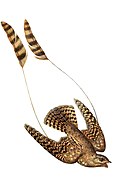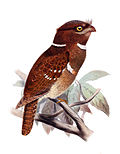| Antrostomus | |
|---|---|
 | |
| Chuck-will's-widow (Antrostomus carolinensis) | |
| Scientific classification | |
| Kingdom: | Animalia |
| Phylum: | Chordata |
| Class: | Aves |
| Clade: | Strisores |
| Order: | Caprimulgiformes |
| Family: | Caprimulgidae |
| Genus: | Antrostomus Bonaparte, 1838 |
| Species | |
see text. | |
Antrostomus is a genus of nightjars formerly included in the genus Caprimulgus . They are medium-sized nocturnal birds with long pointed wings, short legs and short bills.
Contents
Antrostomus nightjars are found in the New World, and like other nightjars they usually nest on the ground. They are mostly active in the late evening and early morning or at night, and feed predominantly on moths and other large flying insects. Most have small feet, of little use for walking, and their soft plumage is cryptically coloured to resemble bark or leaves. They have relatively long bills and rictal bristles. Some species, unusually for birds, perch along a branch, rather than across it, which helps to conceal them during the day. Temperate species are strongly migratory, wintering in the tropics. Many have repetitive and often mechanical songs.














